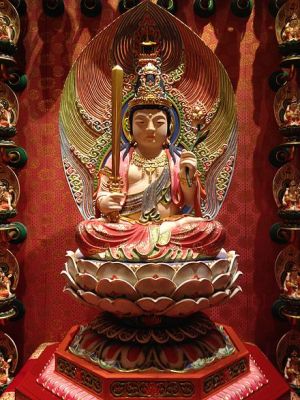Asankheyyakappa
The mahakappa is divided into four phases called asankheyyakappas (incalculable aeons) which can't be calculated by conventional means, and they are by no means equal periods. The first is the dissolution phase, in which the world-system is in a state of decline. The second is the dissolved phase, in which the world-system is in dissolved stasis.
The third is the evolution phase, in which the world-system has begun to reform once again. Finally the evolved phase takes place, in which the formative processes of the world-system have brought about the evolved stasis of a living, organically functioning planet.
- During the first asankheyyakappa, the dissolution phase, the sustaining processes of the world begin to break down and the system continues to deteriorate for an incalculable period. During this break-down, the beings of the lower planes pass away and ascend into higher planes en mass.
This ascension from lower-to-higher states takes place consecutively, and as a result the planes are emptied and destroyed from the "bottom" up. This kammic expurgation of beings eventually results in a complete dissolution of the world-system, in which the planet and solar structure has been immolated, following into the second asankheyyakappa.
- During the second asankheyyakappa, the dissolved phase, beings have mostly be born as Gods of Streaming Radiance (17th plane, Form realm), and so they remain for a very long time. (The lifespan of this plane is 8 mahakappas.) During the entirety of this phase, there persists to be no world-system. Near the end of the asankheyyakappa, a new solar-system begins to be reborn.
- During the third asankheyyakappa, the evolution phase, a being passes away from a higher plane into Mahabrahma. He arises in this world of fine-matter to find himself utterly alone, as the world-system begins to reform, and remains there for a very long time. Eventually he begins to feel isolated, and at that point several other beings pass away into this plane. Then the perception arises in him that he is their creator, and they too have this perception. Then there
ensues a continual process of dissension as beings pass away and the depletion of their kammic merit gradually brings them to rebirths in lower states. Eventually, some of these beings pass away into the human plane, on "earth", composed of subtle matter, floating about, self-luminous. At this time the sun and the moon have not yet appeared in the gloom, and there has not developed sexuality or any discrimination between beings (beings being reckoned only as beings),
and this continues for a very long time. At last, a savory nutriment--like the foam that forms on rice as its cooking, colored like fine ghee--appears on the surface of the great ocean. Some of the beings who have become of a greedy nature (as a result of kamma) partake in this nutriment, and eventually in consequence lose their self-luminance. Now the light of the sun penetrates through the gloom, and the moon and the stars and sky become visible. As beings
continue to consume the nutriment, their composition becomes less subtle and they continue to degenerate into gross material beings. Moreover, they begin to develop physical distinctions and some of them even disposition toward other groups. At the beginning of this degeneration, the savory earth-nutriment disappears and is replaced by fungi-like organisms, of which the beings also partake. This is the beginning of a long process of devolution, in which the
beings develop sex-organs and differentiate into other classes and continue to degenerate in an increasing number of various branches, according to increasing immorality (due to kamma). Whilst this occurs, the primary source of nutriment for human beings is replaced several times; from fungi, to bamboo-like "creepers", and then to hardy rice-like plants. Finally this process of devolution bottoms out to the most rudimentary forms of sentient creatures, which are the first to become beings of completely gross composition. The forms of non-sentient life, such as plants and the productive organisms, have also been duly evolved.
- During the fourth asankheyyakappa, the evolved phase, a stable world-system has formed, populated with subtle beings and also gross forms of life (mostly animals & humans). The five orders of law (Seasonal, Biological, Kammic, Phenomenological, Psychological) have come to establish a rapidly convulsing system of sensual planes, due to the kammic devolution of beings from the higher cosmic systems (planes 15-31).
Furthermore, these asankheyyakappas are divided into somewhat of 20 antarakappas (included aeons), in which the human lifespan is said to fluctuate completely from 10 years to 100,000 years according to moral integrity. Keep in mind that much of these "included aeons" elapse during times in which human beings are not completely gross, as we are now in the continued evolution phase (evolved phase).
Yet another periodical term is an asankheyya, which simply means an incalculable period of time in itself, as opposed to an incalculable aeon.
